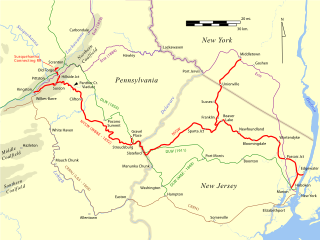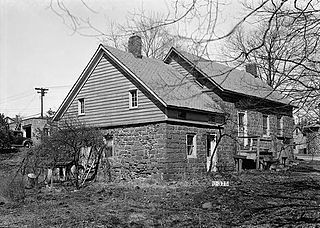
Midland Park is a borough in Bergen County, in the U.S. state of New Jersey. As of the 2020 United States census, the borough's population was 7,014, a decrease of 114 (−1.6%) from the 2010 census count of 7,128, which in turn reflected an increase of 181 (+2.6%) from the 6,947 counted in the 2000 census.

The New York, Susquehanna and Western Railway is a Class II American freight railway operating over 400 miles (645 km) of track in the northeastern U.S. states of New York, Pennsylvania, and New Jersey.

The Bergen County Line is a commuter rail line and service owned and operated by New Jersey Transit in the U.S. state of New Jersey. The line loops off the Main Line between the Meadowlands and Glen Rock, with trains continuing in either direction along the Main Line. It is colored on NJT system maps in grey, and its symbol is a cattail, which are commonly found in the Meadowlands where the line runs.

The New Jersey Midland Railway was a 19th-century predecessor to the New York, Susquehanna and Western Railway (NYS&W) that operated in Northern New Jersey and Orange County, New York.

Weehawken Terminal was the waterfront intermodal terminal on the North River in Weehawken, New Jersey for the New York Central Railroad's West Shore Railroad division, whose route traveled along the west shore of the Hudson River. It opened in 1884 and closed in 1959. The complex contained five ferry slips, sixteen passenger train tracks, car float facilities, and extensive yards. The facility was also used by the New York, Ontario and Western Railway. The terminal was one of five passenger railroad terminals that lined the Hudson Waterfront during the 19th and 20th centuries; the others were located at Hoboken, Pavonia, Exchange Place and Communipaw, with Hoboken being the only one still in use.

The Maywood Station Museum is located in the 1872-built New York, Susquehanna and Western Railway station in Maywood, New Jersey, United States.

The North Hudson Railway Company built and operated a streetcar system in Hudson County and southeast Bergen County, New Jersey before and after the start of the 20th century. It was founded by Hillric J. Bonn who became the first President in 1865 and served for 26 years until his death, and eventually taken over by the Public Service Railway. In its endeavors to overcome the formidable obstacle of ascending the lower Hudson Palisades, or Bergen Hill, it devised numerous innovative engineering solutions including funicular wagon lifts, an inclined elevated railway, an elevator and viaducts.

The Lozier House and Van Riper Mill are located in Midland Park, Bergen County, New Jersey, United States. The house and mill were jointly added to the National Register of Historic Places on October 10, 1975.

Butler is a former commuter railroad train station in the borough of Butler, Morris County, New Jersey. Serving passenger and freight trains of the New York, Susquehanna and Western Railway, Butler served as the western terminus of service beginning in 1941, when passenger service was cut from Stroudsburg, Pennsylvania. Trains from Butler operated to Pavonia Terminal in Jersey City until December 12, 1958 and then Susquehanna Transfer in North Bergen until the discontinuation of service on June 30, 1966. Butler station consisted of a single low-level side platform with the wooden frame station. The next station east was Bloomingdale.

Wortendyke-Demund House is located in Midland Park, Bergen County, New Jersey, United States. The house was built in 1797 and was added to the National Register of Historic Places on January 10, 1983.
Warrington is an unincorporated community located within Knowlton Township in Warren County, in the U.S. state of New Jersey.
Townsbury is an unincorporated community located within Liberty Township in Warren County, in the U.S. state of New Jersey.
Kingsland is an unincorporated community located within Lyndhurst Township in Bergen County, in the U.S. state of New Jersey. and the site of Kingsland station. The Kingsland Avenue Bridge is nearby.

Wortendyke is a former commuter railroad train station in the borough of Midland Park, Bergen County, New Jersey. The station serviced passenger and freight trains of the New York, Susquehanna and Western Railway between Pavonia Terminal in Jersey City and Butler station until December 12, 1958, when the former changed its destination to Susquehanna Transfer in North Bergen. The next station eastbound was the namesake Midland Park station and westbound was Wyckoff. Wortendyke station consisted of a single low-level side platform with the 50 by 16 feet wooden frame station depot.

Ridgefield Park station, also known as West Shore Station, was a railroad station in Ridgefield Park, New Jersey at the foot of Mount Vernon Street served by the New York, Susquehanna and Western Railroad (NYSW) and the West Shore Railroad, a division of New York Central (NYCRR). The New York, Ontario and Western Railway (NYO&W) had running rights along the West Shore and sometimes stopped at Ridgefield Park. First opened in 1872 it was one of three passenger stations in the village, the others being the Little Ferry station to the south and Westview station to the north. Service on the West Shore Railroad began in 1883. The station house, built at a cost $100,000 opened in 1927. Southbound service crossed Overpeck Creek and continued to terminals on the Hudson River waterfront where there was connecting ferry service across the Hudson River to Manhattan. Northbound near Bogota the parallel NYSW and West Shore lines diverge and continue into northern New Jersey, Pennsylvania, and upstate New York. Passenger service ended in 1966.

Vreeland Avenue was railroad station in Paterson, New Jersey served by the New York, Susquehanna and Western Railroad (NYS&W). until 1966. Service by the New Jersey Midland, a predecessor to the NYS&W, had begun in 1873. The station house dates to 1949. Other extant station buildings from the New Jersey Midland/NYSW can be found at Wortendyke, Butler, and Newfoundland, among other places.

Newfoundland is a railroad station in the Newfoundland section of Jefferson Township, New Jersey. It was built by the New Jersey Midland Railway in 1872 and later served passengers on the New York, Susquehanna and Western Railroad (NYS&W).

Wyckoff is a former commuter railroad train station in the township of Wyckoff, Bergen County, New Jersey. The station served trains of the New York, Susquehanna and Western Railway between Pavonia Terminal in Jersey City or Susquehanna Transfer in North Bergen to the station in Butler. The next station east was Wortendyke in Midland Park while the next one west was Campgaw station in Franklin Lakes. Wyckoff station consisted of one track and one low-level side platform for passenger service.

Bogota was a railroad station in Bogota, New Jersey, at Court Street/Fort Lee Road west of River Road and east of the Court Street Bridge over the Hackensack River. It was located on the New York, Susquehanna and Western Railway Main Line, which provided passenger service between the 1870s and 1960s.

North Bergen was a railroad station in North Bergen, New Jersey, United States known Homestead for most of its existence. It as built in the mid 19th century and served by the New York, Susquehanna and Western Railway (#1059) and the Erie Railroad's Northern Branch (#1903).




















